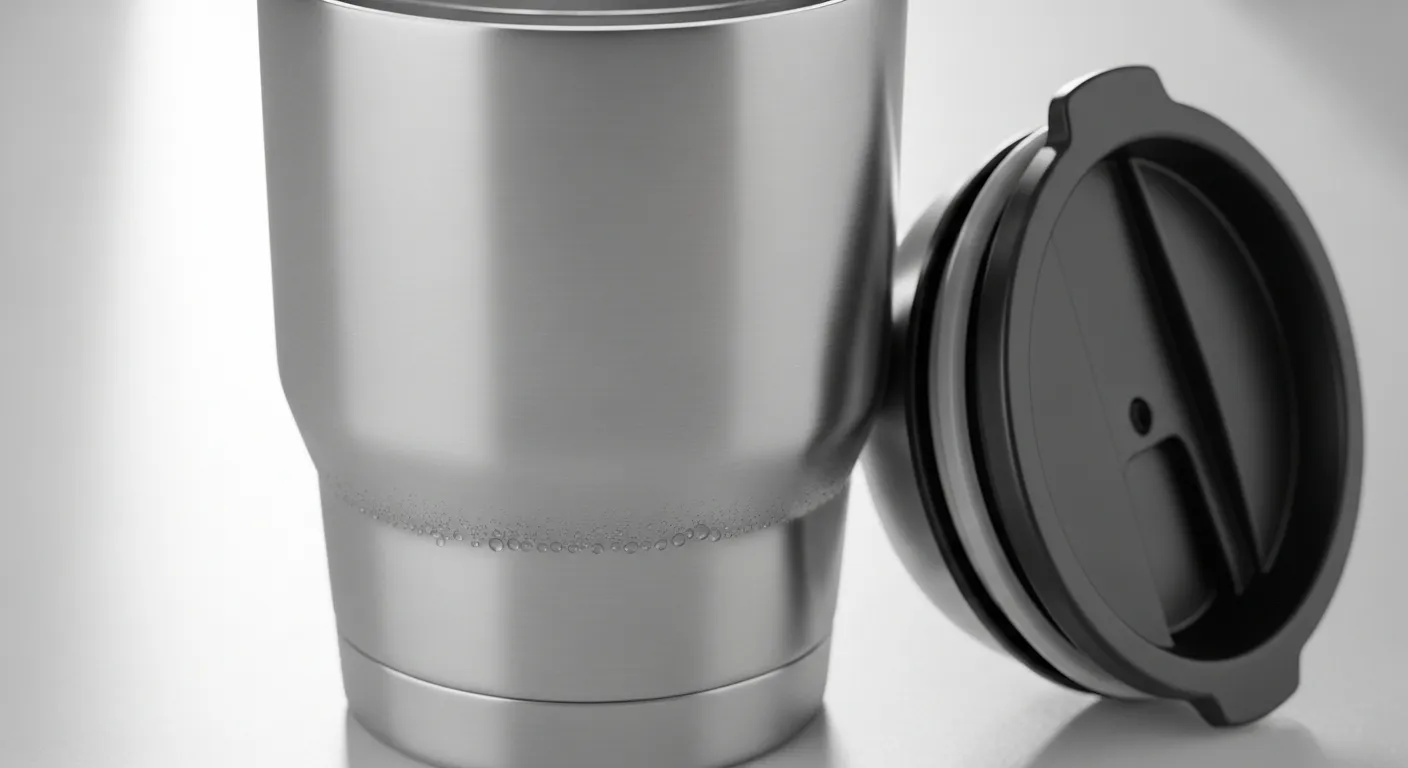
Blog
Travel Tumbler Materials: Which is Most Durable and Leak-Proof for On-the-Go Drinks?

Discover the 4 Top Materials for Travel Tumblers: A Comprehensive Comparison
Hey travel buddies! Ever wondered what makes your travel tumbler *the best* for daily adventures? Seeking the best material for travel tumblers? There’s no single perfect answer. Many options offer different benefits for durability, temperature, and taste.
We’ll explore four main contenders. Understanding each material will transform how you choose your next sip companion.
Here’s a quick peek at the top materials:
- Stainless Steel: The undisputed champ for durability and insulation. It’s the go-to for many a stainless steel tumbler or insulated coffee mug.
- Glass: Ideal for a pure taste and an elegant, eco-conscious glass travel mug.
- Plastic: Super lightweight and budget-friendly, especially BPA-free plastic options.
- Ceramic-Lined: The rising star, great for eliminating metallic tastes and easy cleaning in your ceramic lined tumbler.
Each material brings unique strengths. You’ll soon know your ultimate match for leak-proof, long-lasting enjoyment!
Stainless Steel Reigns Supreme: Unpacking the Durability and Insulation Benefits

Alright, let’s dive into the undisputed champion: stainless steel. When you’re considering the best material for travel tumblers, especially for daily commutes or adventurous trips, stainless steel almost always comes out on top.
Why is it such a fan favorite? Two words: durability and insulation. This material is incredibly tough, shrugging off bumps, drops, and scrapes that would shatter glass or crack plastic, making it a truly resilient choice.
You won’t have to worry about your drinkware breaking if it tumbles out of your bag. A good stainless steel tumbler is built to last for years, proving itself as a smart long-term investment for reliable on-the-go drinks.
Then there’s the insulation magic. Most high-quality stainless steel options feature double-wall vacuum insulation. This smart design creates a barrier that keeps your hot drinks piping hot and your cold drinks refreshingly chilly for hours.
Imagine enjoying hot coffee hours into your road trip, or ice-cold water after a hike! This is why it’s the go-to for many an insulated coffee mug. For its robust nature and superior thermal performance, it’s often hailed as the best material for travel tumblers when these qualities are paramount.
Exploring Eco-Friendly Glass and Lightweight Plastic Tumbler Options
While stainless steel often wins on toughness, the search for the best material for travel tumblers also leads to other choices. For pure taste and an eco-friendly vibe, a glass travel mug is appealing. Glass never holds flavors, so drinks taste fresh.
It’s highly recyclable too. But the big catch is fragility. One drop can mean shattering, which isn’t ideal for active travel or daily commutes.
Then there are plastic tumblers. They’re usually the lightest and most affordable, great for easy carrying. Always choose BPA-free plastic for safety, preventing unwanted chemicals. For more information on BPA and its regulation, you can consult resources like the U.S. Food and Drug Administration (FDA).
Plastic, however, generally lacks the insulation of a stainless steel tumbler or an insulated coffee mug. It can absorb flavors and isn’t as durable. While offering specific perks, glass and plastic have clear limitations when seeking the best material for travel tumblers for lasting, reliable use.
Ceramic-Lined Tumblers: The Secret to Pure Taste and Easy Cleaning
Beyond stainless steel, glass, and plastic, there’s a rising star for pure taste: the ceramic-lined tumbler. Say goodbye to metallic aftertastes!
These tumblers combine a durable, insulating stainless steel core with a smooth interior ceramic coating. This lining acts as a fantastic barrier against flavor transfer from any previous drink.
Your coffee won’t taste like yesterday’s tea, guaranteed! They’re also incredibly easy to clean, resisting stains and making wash-up a breeze. This makes them a strong contender for the best material for travel tumblers if taste is your priority.
A regular stainless steel tumbler insulates great, but some dislike its subtle taste. Compared to BPA-free plastic, ceramic lining truly excels in taste purity and stain resistance.
It offers the robust insulation of an insulated coffee mug and the clean taste of a glass travel mug, but without the breakage risk. That’s a huge win for on-the-go convenience.
However, be cautious of hard drops; the ceramic can chip. Still, for pristine taste and effortless cleaning, a ceramic-lined tumbler is a highly appealing choice.
How to Choose the Absolute Best Material for Your Travel Tumbler: Key Factors Revealed

So, you’ve seen the pros and cons of different materials. Now, how do you pick the best material for travel tumblers for *your* lifestyle? Finding the best material for travel tumblers really depends on what you value most. Let’s look at the key things to consider.
- Your Daily Routine: Are you prone to dropping things? A super durable stainless steel tumbler might be your best bet. If you mostly use it at your desk, a beautiful but more fragile glass travel mug or ceramic-lined tumbler could work.
- Temperature Needs: Do you *need* your coffee piping hot for hours or your water icy cold all day? Then superior insulation is paramount, making an insulated coffee mug (usually stainless steel) the clear winner.
- Taste Sensitivity: If you really dislike any subtle metallic or plastic flavors, a ceramic-lined tumbler is fantastic for a pure taste experience. Even a good BPA-free plastic option might not cut it if you’re super picky.
- Weight and Portability: For ultimate lightness, BPA-free plastic is king. Stainless steel is a bit heavier but offers more robustness. Glass and ceramic-lined options sit in the middle, offering good feel but with some weight.
- Ease of Cleaning: Most materials are pretty easy, but ceramic linings often boast the best stain resistance, making them a breeze to maintain.
Think about these factors, and you’ll easily pinpoint your perfect travel companion!
Solving Your Biggest Doubts: Essential Answers to Travel Tumbler Material Questions
Got doubts about the best material for travel tumblers? Here are quick, clear answers to your top questions!
- Is BPA-free plastic truly safe? Yes! Reputable brands use food-grade BPA-free plastic. It’s a safe, lightweight, and affordable choice for daily use.
- Does stainless steel leave a metallic taste? Usually no, for quality stainless steel tumbler. For ultimate taste purity, a ceramic-lined tumbler is best.
- Are glass travel mugs too fragile? Yes, a glass travel mug is more breakable. Best for careful handling; offers pure taste but needs caution.
- Are ceramic-lined tumblers heavy or breakable? Slightly heavier. The ceramic lining is durable, often backed by stainless steel. Many insulated coffee mug options use this for pure taste.
- Which material is most leak-proof? Leak-proofing relies on lid design/seal. Durable materials like a stainless steel tumbler maintain shape, ensuring a secure fit – key for the best material for travel tumblers.
Frequently Asked Questions
Beyond the Tumbler Body, Do Lid and Seal Materials Matter for Leak-Proofing?
Absolutely, they’re critical! The lid is often the unsung hero (or villain) of your tumbler’s performance. Look for lids made from high-quality, BPA-free plastic, often paired with silicone gaskets or O-rings. These materials provide the flexible, tight seal needed to prevent leaks, especially when combined with a secure closure mechanism. A top-notch tumbler body can be completely undermined by a poorly designed or inferior lid material, so definitely pay attention to this detail!
Does the Tumbler Material Affect the Taste of My Drink?
It certainly can! This is a big one for connoisseurs of coffee, tea, or even just plain water. Stainless steel is widely praised for being taste-neutral, meaning it won’t impart any metallic or chemical flavors to your beverage, offering a pure sip. Glass tumblers also provide an entirely taste-free experience, perfect for enjoying the nuanced flavors of your drink. Plastic, however, can sometimes impart a subtle “plasticky” taste, especially when new, with hot liquids, or if not thoroughly cleaned, which can detract from your drinking experience.
Which Travel Tumbler Material is the Most Eco-Friendly?
That’s a fantastic and increasingly important question with a nuanced answer! Stainless steel generally takes the lead here. It’s incredibly durable, meaning a single tumbler can last for years (or even decades!), reducing waste. Plus, it’s 100% recyclable at the end of its very long life. Glass is also made from abundant, natural materials and is recyclable, though its fragility means it might not last as long if dropped frequently. Plastic, while convenient, generally has a higher environmental footprint due to its production and disposal challenges. Ultimately, the most eco-friendly tumbler is the one you use consistently and care for, preventing the need for frequent replacements, regardless of material!
How Do I Best Maintain and Clean Different Tumbler Materials for Longevity?
Keeping your tumbler sparkling clean is key to its lifespan and your health!
Stainless Steel: Many are dishwasher safe, but hand-washing with warm, soapy water and a bottle brush is often recommended to protect the exterior finish and vacuum insulation integrity. Pay extra attention to the lid’s gasket!
Plastic: Most plastic tumblers are dishwasher safe (top rack recommended), but hand-washing can prevent potential warping or residue buildup. Ensure all parts, especially intricate lid mechanisms, are thoroughly cleaned.
Glass: Typically dishwasher safe, but if your glass tumbler has a protective silicone sleeve, it might be better to hand-wash both separately.
For all materials, fully disassemble the lid (if possible) and thoroughly clean gaskets and seals to prevent mold and lingering odors. Proper drying after washing is also crucial!
